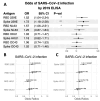High transmission of endemic human coronaviruses before and during the COVID-19 pandemic in adolescents in Cebu, Philippines
- PMID: 39333882
- PMCID: PMC11430261
- DOI: 10.1186/s12879-024-09672-8
High transmission of endemic human coronaviruses before and during the COVID-19 pandemic in adolescents in Cebu, Philippines
Abstract
Background: SARS-CoV-2, the causative agent of COVID-19, is a betacoronavirus belonging to the same genus as endemic human coronaviruses (hCoVs) OC43 and HKU1 and is distinct from alpha hCoVs 229E and NL63. In a study of adolescents in the Philippines, we evaluated seroprevalence to the hCoVs, whether pre-pandemic hCoV immunity modulated subsequent risk of SARS-CoV-2 infection, and if SARS-CoV-2 infection affected the transmission of the hCoVs.
Methods: From 499 individuals screened in 2021 for SARS-CoV-2 receptor binding domain (RBD) antibodies by enzyme-linked immunosorbent assay (ELISA), we randomly selected 59 SARS-CoV-2 negative and 61 positive individuals for further serological evaluation. We measured RBD and spike antibodies to the four hCoVs and SARS-CoV-2 by ELISA in samples from the same participants collected pre-pandemic (2018-2019) and mid-pandemic (2021), before COVID-19 vaccination.
Results: We observed over 72% seropositivity to the four hCoVs pre-pandemic. Binding antibodies increased with age to 229E and OC43, suggesting endemic circulation, while antibody levels was flat across ages for HKU1 and NL63. During the COVID-19 pandemic, antibodies increased significantly to the RBDs of OC43, NL63, and 229E and spikes of all four hCoVs in both SARS-CoV-2 negative and positive adolescents. Those aged 12-15 years old in 2021 had higher antibodies to RBD and spike of OC43, NL63, and 229E than adolescents the same age in 2019, further demonstrating intense transmission of the hCoVs during the pandemic.
Conclusions: We observe a limited impact of the COVID-19 pandemic on endemic hCoV transmission. This study provides insight into co-circulation of hCoVs and SARS-CoV-2.
Keywords: 229E; COVID-19; Endemic coronaviruses; HKU1; NL63; OC43; Philippines; SARS-CoV-2; Seroprevalence.
© 2024. This is a U.S. Government work and not under copyright protection in the US; foreign copyright protection may apply 2024.
Conflict of interest statement
The authors declare no competing interests.
Figures





Update of
-
High transmission of endemic human coronaviruses before and during the COVID-19 pandemic in adolescents in Cebu, Philippines.Res Sq [Preprint]. 2023 Nov 16:rs.3.rs-3581033. doi: 10.21203/rs.3.rs-3581033/v1. Res Sq. 2023. Update in: BMC Infect Dis. 2024 Sep 27;24(1):1042. doi: 10.1186/s12879-024-09672-8. PMID: 38014070 Free PMC article. Updated. Preprint.
Similar articles
-
High transmission of endemic human coronaviruses before and during the COVID-19 pandemic in adolescents in Cebu, Philippines.Res Sq [Preprint]. 2023 Nov 16:rs.3.rs-3581033. doi: 10.21203/rs.3.rs-3581033/v1. Res Sq. 2023. Update in: BMC Infect Dis. 2024 Sep 27;24(1):1042. doi: 10.1186/s12879-024-09672-8. PMID: 38014070 Free PMC article. Updated. Preprint.
-
Seroprevalence of four endemic human coronaviruses and, reactivity and neutralization capability against SARS-CoV-2 among children in the Philippines.Sci Rep. 2023 Feb 9;13(1):2310. doi: 10.1038/s41598-023-29072-3. Sci Rep. 2023. PMID: 36759702 Free PMC article.
-
Anti-RBD IgG antibodies from endemic coronaviruses do not protect against the acquisition of SARS-CoV-2 infection among exposed uninfected individuals.Front Immunol. 2024 May 23;15:1396603. doi: 10.3389/fimmu.2024.1396603. eCollection 2024. Front Immunol. 2024. PMID: 38846944 Free PMC article.
-
An overview on the seven pathogenic human coronaviruses.Rev Med Virol. 2022 Mar;32(2):e2282. doi: 10.1002/rmv.2282. Epub 2021 Aug 2. Rev Med Virol. 2022. PMID: 34339073 Review.
-
Ocular tropism of coronavirus (CoVs): a comparison of the interaction between the animal-to-human transmitted coronaviruses (SARS-CoV-1, SARS-CoV-2, MERS-CoV, CoV-229E, NL63, OC43, HKU1) and the eye.Int Ophthalmol. 2021 Jan;41(1):349-362. doi: 10.1007/s10792-020-01575-2. Epub 2020 Sep 3. Int Ophthalmol. 2021. PMID: 32880786 Free PMC article. Review.
References
-
- Baloch S, Baloch MA, Zheng T, Pei X. The Coronavirus Disease 2019 (COVID-19) Pandemic. Tohoku J Exp Med. 2020;250:271–8. - PubMed
-
- World Health Organization. WHO Coronavirus (COVID-19) Dashboard. Available at: https://data.who.int/dashboards/covid19/. Accessed 14 Aug 2024.
-
- World Health Organization. Tracking SARS-CoV-2 variants. Available at: https://www.who.int/activities/tracking-SARS-CoV-2-variants. Accessed 14 Aug 2024.
MeSH terms
Substances
Grants and funding
LinkOut - more resources
Full Text Sources
Other Literature Sources
Medical
Miscellaneous

